A few things to consider when choosing the size of your shoes.
How do I work out what size I need?
Ideally you would come into our Ballarat store and try the boots on and we could then help you make the right decision. Trying them on in person is the simplest way to get a feel for the right size. However if you can’t make it in then we have put together a description of all of our sizes.
– Use the ‘How do I measure my size’ to determine what to look for when deciding on the type of shoe that will suit you, or to take measurements from scratch.
– The size chart will help you convert from cm to our sizes or American to our sizes etc. However all of our lasts fit slightly differently so read the following section too.
– ‘Our Lasts’ has a breakdown and description of how each of our lasts fit. We recommend reading through this to help determine which shoe size and style would be best suited to your foot shape.
Finally the last four sections are considerations when determining how you are going to wear your shoes, these are all factors when determining the best fit for you.
How do I measure my size? - Summary
There are a few critical measurements that need to be considered when deciding the type of last that will suit you.
Measurements:(a ruler and flexible tape will be required to take accurate measurements)
– Short heel (or around your heel and ankle), Instep and ball measurements as well as the length of your foot from the back of your heel to the end of your longest toe. (see diagram below) the method required to take these measurements is outlined in the step by step guide below.
Other considerations are:
– Toe box depth and width – if you have wide or splayed toes then a rounder toe will suit you (read about our lasts in the FAQ section ‘our lasts’ below)
– Pitch (this is the difference between the height of the shoe at the heel and the ball of the foot) – a consideration for people who have issues with pressure on their forefoot, the higher the heel the more pressure there.
– Width at ball – Each last will fit slightly differently here, the measurements you take will indicate how your foot matches up with our lasts.
– Height of arch/instep – A higher arch/instep will be better accommodated by a shoe with more adjustment over that area ie. a Derby will be better than an Oxford.
How do I measure my size? - Step 1 - Measuring length
Firstly: Place a ruler against a nice flat wall with the ‘0’ at the point where the wall intersects the floor. (see below)
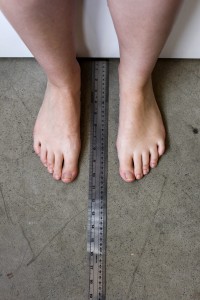
Secondly: This measurement is taken standing. Place one foot at a time on the ruler with your heel against the wall. Place the longest part of your foot over the ruler measurement (this may not be you big toe).
– Look straight down onto the ruler and note the measurement. Be sure to look down so you are seeing the measurements at right angle to the ruler, if your toes are up slightly off the ruler then the angle at which the measurement is viewed can change the measurement you record.
– Also it is important that you are evenly bearing your weight on both feet, in a nicely rested and neutral position, don't put all of your weight on the one foot.
Repeat this for the other foot, note that they may be slightly different lengths (this is quite common).
(see below)
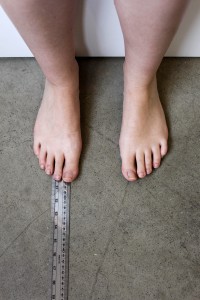
How do I measure my size? - Step 2 - Measuring short heel
You will need a flexible tape (a dress makers tape, these are readily available from any supermarket, haberdashery store or even Ikea). wrap the tape around the back of your heel at the bottom to the front of your ankle at the top and record the measurement where the tape overlaps. It is important that the tape is neither too loose nor tight, you want it to be taught but not tight.
Read the summary page if you are unsure of where this measurement should be taken and see below image for a reference.
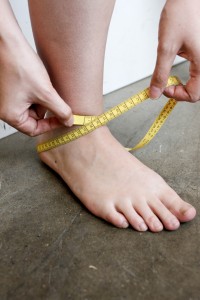
How do I measure my size? - Step 3 - Measuring instep
Take the flexible tape forward and wrap it around the high part of your arch/instep. This should be held at the same tension to the previous step.
Read the summary page if you are unsure of where this measurement should be taken and see below image for a reference.
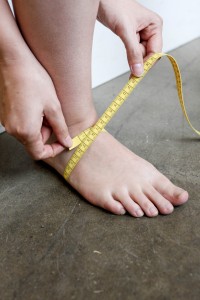
How do I measure my size? - Step 4 - Measuring ball
The final measurement is of the ball (joint) of your foot. This measurement is done across the widest point of your foot and should be on a slight angle (further forward on the big toe side than the little). It should be taken at the widest point of your first big toe joint and the widest point of your little toe joint.
Read the summary page if you are unsure of where this measurement should be taken and see below image for a reference.
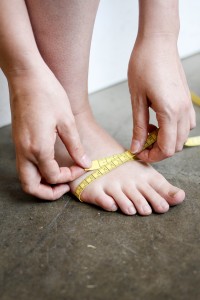
Size Chart
To access the sizing charts you may need to ‘Save the Link As’ on your computer.
Our Lasts
Stanley: Gents
Used on our Original Jack Gusset Boot, the Stanley has a chiseled toe and an anatomically designed form. For this Ready To Wear (RTW) boot, we have used the wider 'E' fitting as our standard width size. It is available from size 8-11.5.
Cambridge: Gents
Generally an ‘E’ fitting last with a lightly tapered toe (almond shaped). Again an anatomically designed form with an asymmetrical cone and footbed. A fairly neutral fitting last (not large or too broad without being narrow either). Available in sizes 6-13. Used on our Classic boots and our Heritage range from the Wootten Heritage site.
Gordon: Gents
An ‘E’ fitting last with a ridged classic boot shaped toe. Again an anatomically designed form with an asymmetrical cone and footbed. A fairly neutral fitting last but we do find customers tend to be half a size down on this last compared to the Cambridge, which this last is modelled from. Used for our Banjo, Bob and Gordon Classic and Heritage boots from our Wootten Heritage site.
Cameron: Gents
An ‘E’ fitting last with a softer and rounder classic boot shaped toe. This is used on our Gordon Original Boot. Again an anatomically designed form with an asymmetrical cone and footbed. This will fit the same as the Gordon last. A fairly neutral fitting last but we do find customers tend to be half a size down on this last compared to the Cambridge, which this last is modelled from.
How do your Original Jack Gusset Boots compare to RM Williams sizing?
If you currently wear RM's in a G fitting and find them comfortable, then our E fitting will fit similarly. Some people do prefer a half size up if they prefer a more generous fit around the ball of the foot. This is dependent on the individual and their foot measurements. If you don't have RM's and are looking at their size chart online to make a comparison, or if you have RM's and find them uncomfortable or too small at the toe, we would typically recommend ordering a half size bigger with us than what RM's are recommending based on your measurements with their table. In order to take measurements correctly please refer to the above steps for How Do I Measure My Size.
Example: If you go through the RM's Size Chart and it recommends you to buy a size 9.5G based on your length and ball measurements, you will find that doing the same process on Wootten's Size Chart would lead you to a size 10 E.
Our Jack Originals are made on our Stanley E fitting last, which fits similarly to the RM's G fitting. Our sizing is also in Australian/UK sizing (as are RM Williams). Our lasts are slightly longer then RM's meaning they ought to allow for the tapered toe and not cause unnecessary pressure in the toe box. Our lasts are asymmetrical and anatomically correct with no feather edge through the waist of the last, which means they ought to give better support through the mid foot and arch.
How does the Gordon/Cameron boot last fit compared to the Stanley/Cambridge dress last?
In 95% of cases, we find that people who have worn our Stanley or Cambridge shoes or boots (in either a D or E fitting), typically drop half a size when going for the Gordon or Cameron.
As an example: If you wear a 9.5 Stanley E, we would recommend going for a size 9 in the Gordon/Cameron last.
Due to the broader toe box of these two lasts and the fact that the boots are a lace up style, this generally allows for a little more wiggle room. Of course if you tend to wear thick socks with your boots with this style of boot then you may end up going for the same size.
What's the difference between AU/UK/US/EU sizing?
We use an AU/UK sizing system, which differs slightly to the US. Typically US sizing is stated as one size larger (ie: If you wear a US 10, that correlates to a AU/UK 9). EU sizing runs an entirely different numbering system, where a 9 AU/UK correlates to a 43EU. Please check out our Size Chart for more details.
Width Fittings - How does your D and E fitting compare to RM's F G and H fittings?
Firstly, the width fitting is denoted by the letter after the size number. Eg: size 9 E, or size 9 D, where the E and D denote the width.
Typically the further down the alphabet the wider the fitting, but each brand will use their own starting point. For example, we start at D, with D being our narrow fitting. And end with E, with E being our widest.
RM's on other hand, start at F, with F being their narrow, and finish at H, with H being their widest.
Our D compares to their F, and our E compares to their G. The point at which you start in the alphabet is entirely arbitrary. We could easily say X, Y and Z as we do A, B and C.
If you are a H fitting in your RM's, you may be looking at a half size up in our E Stanley and Cambridge.
What's the difference between men's and women's sizing?
Men's sizing is typically two length sizes larger and one width fitting wider than women's sizing. For example: If you wear a size 9 D Ladies Cambridge, then you would fit a size 7 D men's fitting. The industry standard size for women's lasts is a D fitting, whereas the industry standard size for men's is an E fitting. This is how our sizing runs.
I'm a lady's foot size and am interested in your Gordon or Jack Originals, but you only go down to a size 8 mens. What should I go for?
As stated above, women's sizing runs two length sizes smaller and one width fitting narrower. Here's a handy comparison:
8 D Ladies = 6 D Stanley and 5 E Gordon/Cameron 9 D Ladies = 7 D Stanley and 6 E Gordon/Cameron 10 D Ladies = 8 D Stanley and 7 E Gordon/Cameron
If you typically find yourself needing a slightly wider fit than what is readily available off the shelf for ladies, then the following applies:
8 wide Ladies = 6 E Stanley and 5.5 E Gordon/Cameron 9 wide Ladies = 7 E Stanley and 6.5 E Gordon/Cameron 10 wide Ladies = 8 E Stanley and 7.5 E Gordon/Cameron
Please note the width fitting available for the Originals is a men's E so for women we are only able to offer a wide fitting. The Classics are available in men's D as well as E.
Please see our "how do I measure my size" guide as to how to take measurements correctly and compare this to our "size chart" for your corresponding size.
What sort of socks will you be wearing with them?
The thickness of your sock can vary the fitting of your shoes up to a half size. If you are trying them on with a business sock but intend to wear a padded sock or explorer style sock with them then you may need to increase the size by a half size.
What style of shoes are they?
If they are lace ups then they can be slightly looser than if they are slip-on’s. So if you are after an every day shoe then we would always recommend a shoe with some sort of adjustment (laces are the best for this) as this will allow for slight variations in the size of your feet during the day without becoming uncomfortable. If you fly a lot then this is especially important.
What shape/sort of foot do I have?
If you have a high instep then a derby construction (such as in our Gordon Boot) will typically be better for you than a traditional Chelsea boot (like our Jack Gusset Boot), which has no laces to relieve that area. A broader toe will suit a broader foot and a higher cut topline will suit a narrow ankle.
